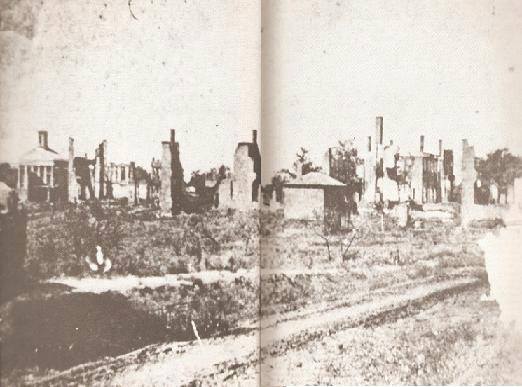
By the time Union General Andrew “Whiskey” Smith turned the flames loose on Oxford, William Smith Neilson had been an Oxford town father and leading businessman for 25 years. He and Oxford had remained steadfast in the face of Ole Miss’ dying boy’s cries from Gettysburg and the Mississippi moans of our dying kin at Vicksburg, who, rather than surrender, starved to death in the cliffs over the river. So, with Yankee torches and Oxford’s end crossing the Tallahatchie, W. S. Neilson gathered all he had and left his store for the last time. And as the flames glowed in the northern sky, ashes to ashes went the Square. But dust to dust had gone Neilson’s gold, and the Square’s new start, buried in the yard at Shadowlawn.
In 1864, long before little Billy Falkner could count his lucky stars for growing up in Oxford, Mississippi, there wasn’t much under the stars left to count. So much, and little, so that in the first meeting of the broken town’s fathers, only two short measures were passed. First, the notice that Oxford had no funds or surveyor. The property owners would have to clear away their own ashes and draw off new property lines, as best they could. Second, the town Marshal was ordered to make a list of the slave families walking in freely from their old Lafayette County ex-farms. As best he could, the Marshal’s list was to address the needs of the new citizens. They would need food and shelter. The meeting adjourned.
In 1864, long before little Billy Falkner could count his lucky stars for growing up in Oxford, Mississippi, there wasn’t much under the stars left to count. So much, and little, so that in the first meeting of the broken town’s fathers, only two short measures were passed. First, the notice that Oxford had no funds or surveyor. The property owners would have to clear away their own ashes and draw off new property lines, as best they could. Second, the town Marshal was ordered to make a list of the slave families walking in freely from their old Lafayette County ex-farms. As best he could, the Marshal’s list was to address the needs of the new citizens. They would need food and shelter. The meeting adjourned.

For eight years Oxford met and adjourned, where it could, as best it could. The burned out Square had been anchored by the old Lafayette County Courthouse. Now that seemed a lifetime ago. But, in 1872 federal judge Robert Andrews Hill secured funds to build a new courthouse. And though we picked ourselves up slowly, finally, here we came.

Courtesy of John Cofield. John Cofield is a hottytoddy.com writer and one of Oxford’s leading folk historians. He is the son of renowned university photographer Jack Cofield. His grandfather, “Col.” J. R. Cofield, was William Faulkner’s personal photographer and for decades was Ole Miss yearbook photographer. Cofield attended Ole Miss as well. Contact John at johnbcofield@gmail.com
Recent Comments